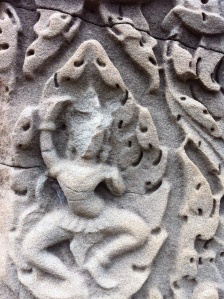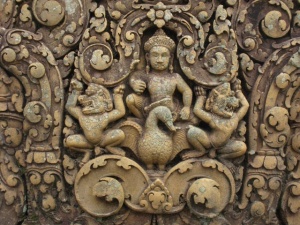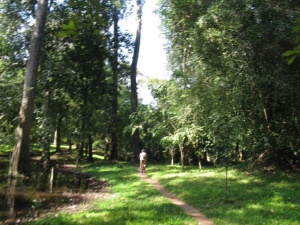I’ll be the first to admit that we do not have a realistic or diverse perspective on Cambodia. Barely three days ; we stayed in splendor and saw ancient structures that were simply jaw-dropping. Not a fair way to assess a complex country with a complex history. But what we saw, and the people we experienced, we loved. One odd detail, two actually. Cambodians happily accept and prefer the U.S. Dollar for transactions. However, they’ll only accept relatively new bills..too wrinkled or any tears whatsoever and they will simply refuse to accept it. Who knew??
Let me just say, if you’re ever thinking of going to see Angor Wat and the other temples and structures in this UNESCO World Heritage site, let us know. We have the place for you to stay: The Golden Banana (yes, that’s the real name). Ask us if you’re interested in having fresh mango daiquiris delivered to your room so you can enjoy them on your own bougainvillea enshrouded balcony over-looking the saltwater pool. Hey, it was my 60th birthday…I got to celebrate!!
As for Angor….there is a reason this area is included as a UNESCO World Heritage site (http://whc.unesco.org/en/list/668). Our guide for two days took us to many of the smaller temples the first day, managing to (mostly) avoid the throngs of Japanese tourists that swarm by the bus loads across the more popular sites. There were several temples we visited where we were the only people there or perhaps as few as four others. Seeing some of these places when it is quiet, and you can hear the birds in the surrounding forests, gives one a greater sense of the grandeur of the area. There were more than one million people living in the greater Angor Wat area in its heyday, so it would not have been serene or quiet at that time!
The 400 square kilometer area is commonly (incorrectly) referred to as””Angor Wat”; however that is actually only largely intact temple complex. There are actually many temples and palaces that have been recovered from the persistent forests and, according to National Geographic, there are likely thousands more still enclosed and obscured by jungle for many miles surrounding the known/recovered structures.
Buildings were started in the 9th century and construction continued until the 15th. The remaining structures are predominantly temples because all the thousands and thousands of wooden structures have long ago been reclaimed by the jungle. Many of the temples were built by Buddhist Kings of the Khmer regimes. One of the more fascinating aspects of the older temples Is that when the religious affiliation of the presiding Kings shifted from Buddhist to Hindu, all of the images of Buddha within the temples were destroyed, defaced, or removed by the newest successor. Hence a lot of the evident damage to the carvings was inflicted by the Khmer themselves even while there were building more temples and edifices (some for mothers and grandmothers of then existing kings).
Over the millennia, the fixation with women’s breasts has clearly remained constant (well, who knows, it may have waxed and waned in popularity, but it certainly appears that the fixation remained pretty consistent). Nude female figures are prevalent throughout all the structures, and consistently the accessible mammaries are stained darker than the surrounding parts of the carvings due to the oils from people’s hands touching them. That, or the breasts are damaged and defaced in some manner (though not as thoroughly as Buddha was removed or beheaded).
The structures themselves are built out of two kinds of stone. Structurally they are a stone that appears volcanic, mined from two nearby mountains, and brought down to the area by teams of elephants. The second type of stone we think was a much finer-grained sandstone, so that it could be carved in far more intricate detail and hold the images. The carvings are astounding in their details and shear multitudes. Our images here can only begin to give your the barest sense of what is here. Earlier temples are resplendent with images depicting the various Buddhist and then Hindu gods and creatures that populate the mythology. Ask us about the meanings of multiple headed snakes or horses or elephants, dancing women, Shiva or Buddha sitting above the sea or above armies of warring monkeys…we should be experts by now. But you know, repetition is NOT an effective teaching method. We saw hundreds of images of Shiva, Vishnu, Ganesha and Brahma, but sadly we are not more enlightened as to the complexities of the Hindu religion.

Perfectly cut and fitted joinery with imperfect tools between structural, porous stone and more dense decorative sandstone
We are, however, more acutely aware of the sentiment of some of the population to the current government of Cambodia. We had long conversations with our guide and interpreter about his feeling about the government. And that he had been to Phenom Penh in the last month to join the mass protests against the current head of the government. In the last election it is the opinion of many people (per our guide), that the election was stolen. They have delivered thousands of petitions to Ambassadors and heads of States from many nations (including former Secretary Hillary and Barack) protesting the election results. He is so emphatic about rescuing his country that he is going to school to become a lawyer…all while supporting his “old” mother a widow,(she’s 62 so we cautioned him not to refer to her as “old”) and his sisters who are not married. He comes from a small village and a very poor family, but moved to Siem Reap to get a job in the exploding tourist industry.
According to him, 10 years ago there was very little tourist industry in Siem Reap and certainly not in greater Cambodia. Now the city/province generates hundreds of millions of dollars in revenues. Buildings are going up left, right, and center. And very little of the financial benefits of this growth are “trickling down” to the people. According to him, the authorities skim off most of the monies via bribes and outright theft. Corruption is rampant and the poor are falling further behind as their lands are taken for resort and building projects, while the rich are getting richer (sounds like a familiar story, sadly). He also noted that due info the recent civil war, huge tracks of forests were cut and sold to neighboring counties and even jewel encrusted walls in some of the Angor temples were stripped and sold to pay for the war.
Our second day of seeing the delights was improved a thousand-fold when we got to bicycle to the temples and then “single-track” on our mountain bikes back to seldom visited areas through some of the small villages that remain within the protected zone. What fun! After a day and a half seeing remains and partial structures, the last place we went was the temple of Angor Wat itself.

Sovann our guide carrying our mountain bikes thru the back entryway and over the rubble…he wouldn’t have it otherwise!
———————
I started this in the Seoul airport on our long journey home. Now we’re hanging in Tokyo for too long. I’d to get this much out before we get home because I know the magic of the journey will too soon dissipate once we get home. Jean will add her wonderful perspectives on Angor Wat when she is inspired.
Jean here…adding a few thoughts after a bit of cat napping on the stiff airport waiting area bench-seats. Being at a World Heritage site situates you in time, space, spirit, cultural history(the bit one can grasp in the vastness) and an immediacy of feeling small and humble. Power is portrayed in the physical structure, again the vastness in temples like these, and in the magnitude of effort and time it took to build. Angor Wat alone took 40 years…40,000 elephants and untold tens of thousands of human laborers. Our guide could rattle off all the astounding numbers and metrics associated with each of the temples we experienced. I lost track of the specifics but am left with the immensity of vision, power, passage of time and shifting power struggles to make all of it come to life. Here’s another astounding revelation you have studying these structures. The whole is a series of interconnecting parts…each sculpted element with its intricate carving is a part of the whole, sculpted separately then assembled with its adjacent elements. These structures and their friezes, lovely ladies, powerful warriors, elephants with three trunks, Sivas, Vishnues are not single whole and intact sculptures but each small chunk a part of the huge, towering whole. The sum of the parts are awesomely greater than each individually. Was it the god-power of the all seeing third eye that could envision this whole? World Heritage sites have the magnitude to push mental, emotional and spiritual boundaries.

















Lovely & familiar. Thanks to you both for all your wonderful observations and photos. Marty & Jane
Such an interesting and colorful report! Thank you for sharing your travels with us!
Fascinating, evocative, thank you.
You’re leaving already? it went so fast and we’ve been there with you. love, Linny